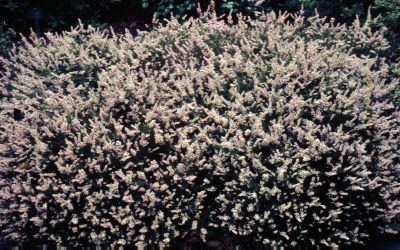Nomenclature
Calluna Salisb., Trans. Linn. Soc. Lond. 6: 317. 1802.
TYPE: Calluna vulgaris (L.) Hull.
Key to the species of Calluna
List of Calluna Species
References to Calluna
- Aerts, R.; Boot, R. G. A.; van-der Aart, P. J. M. 1991. The relation between above- and belowground biomass allocation patterns and competitive ability. Oecologia 87: 551-9.
- Anderson, S. M. 1958. Factors affecting germination and seedling establishment in Calluna vulgaris (L.) Hull. , Thesis Univ. of Aberdeen,
- Barclay, E. P. 1991. Scottish heather, Calluna vulgaris (L.) Hull, in eastern Canada. Naturaliste Canad. 118: 47-55.
- Beijerinck, W. 1940. Calluna: a monograph on the Scotch heather. Kon. Ned. Akad. Wet., Verh. 38: 1-180.
- Clarkson, R. B. 1958. Scotch heather in North America. Castanea 23: 119-29.
- Craig, M. E. 1955. Studies anatomical and physiological on the fruits and seeds of Calluna vulgaris L. and Erica cinerea L. , Thesis Univ. of Edinburgh,
- Dixon, G. R.; Dutton, K. J. 1987. Manipulation of flowering in white heather. Acta. Hortic. 205: 219-24.
- Don, D. 1834. An attempt at a new arrangement of the Ericaceae. Edinburgh New Philos. J. 17: 150-60.
- Eaton, R. J. 1933. Another Massachusetts station for Calluna vulgaris. Rhodora 35(416): 294.
- Equihua, M.; Usher, M. B. 1993. Impact of carpets of the invasive moss Campylopus introflexus on Calluna vulgaris regeneration. J. Ecol. 81: 359-65.
- Gimingham, C. H. 1972. Ecology of heathlands. Chapman and Hall, London. , xv, 266 pages.
- Gimingham, C. H. 1960. Biological Flora of the British Isles. Calluna vulgaris (L.) Hull. J. Ecol. 48: 455.
- Grevillius, A. Y.; Kirchner, O. 1923. Ericaceae. In: Lebensgeschichte der Blütenpflanzen Mitteleuropas. Vol. 4(1). Verlagsbuchhandlung Eugen Ulmer, Stuttgart. , 1-164 pages.
- Hagerup, O. 1928. Morphological and cytological studies of Bicornes. Dansk Bot. Ark. 6: 1-27.
- Hagerup, O. 1954. Autogamy in some drooping Bicornes flowers. Bot. Tidsskr. 51: 103-9.
- Hagerup, O. 1950. Thrips pollination in Calluna. Biol. Meddel. Kongel. Danske Vidensk. Selsk. 18: 1-16.
- Haslerud, H-D. 1974. Pollination of some Ericaceae in Norway. Norweg. J. Bot. 21: 211-6.
- Hermann, P. M.; Palser, B. F. 2000. Stamen development in the Ericaceae. I. Anther wall, microsporogenesis, inversion, and appendages. Amer. J. Bot. 87: 934-957.
- Hester, A. J.; Gimingham, C. H.; Miles, J. 1991. Succession from heather moorland to birch woodland. III. Seed availability, germination and early growth. J. Ecol. 79: 329-44.
- Jarvis, C. E.; McClintock, D. 1990. Notes on the typification of fourteen Linnaean names for European species of Erica, Calluna, and Andromeda (Ericaceae). Taxon 39: 517-20.
- Knudson, L. 1929. Seed germination and growth of Calluna. New Phyt. 28: 369-76, pl. 7-9.
- Knudson, L. 1933. Non-symbiotic development of seedlings of Calluna. New Phyt. 32: 115-27, pl. 6-7.
- Knudson, L. 1928. Is the fungus necessary for development of seedlings of Calluna vulgaris? Amer. J. Bot. 15: 624-5.
- Kron, K. A. 1996. Phylogenetic relationships of Empetraceae, Epacridaceae, Ericaceae, Monotropaceae, and Pyrolaceae: evidence from nuclear ribosomal 18s sequence data. Ann. Bot. (UK) 77(4): 293-303.
- Kron, K. A.; Chase, M. W. 1993. Systematics of the Ericaceae, Empetraceae, Epacridaceae and related taxa based upon rbcL sequence data. Ann. Missouri Bot. Gard. 80: 735-41.
- Legg, C. J.; Maltby, E.; Proctor, M. C. F. 1992. The ecology of severe moorland fire on the North York Moors: seed distribution and seedling establishment of Calluna vulgaris. J. Ecol. 80: 737-52.
- Leins, P. 1964. Entwicklungsgeschichtliche Studien an Ericales-Bluten. Bot. Jahrb. Syst. 83: 57-88. (In German)
- Littlefield, E. W. 1931. A new station for Calluna. Rhodora 33(391): 162-3.
- Luteyn, J. L.; Clemants, Steven E.; et al. et.al. 1996. Ericaceae of the southeastern United States. Castanea 61(2): 101-44.
- Mahy, G.; Jacquemart, A. L. 1998. Mating system of Calluna vulgaris: self-sterility and outcrossing estimations. Canad. J. Bot. 76: 37-42.
- Matthews, R. F. 1993. Calluna vulgaris. ()
- Mohamed, B. F.; Gimingham, C. H. 1970. The morphology of vegetative regeneration in Calluna vulgaris. New Phyt. 69: 743-50.
- Munson, R. H. 1984. Heaths and heathers cultivated in North America (Ericaceae). Baileya 22: 101-3.
- Nordhagen, R. 1938. Studien ³ber die monotypische Gattung Calluna Salis. II. Ein Betrag zur Bicornes. Bergens Mus. Årbok 1938: 1-70.
- Nordhagen, R. 1937. Studien ³ber die monotypische Gattung Calluna Salis. I. Ein Betrag zur Bicornes. Bergens Mus. Årbok 1937: 1-55.
- Oldfield, F. 1959. The pollen morphology of some of the West European Ericales. Pollen & Spores 1: 19-48.
- Pearson, V.; Read, D. J. 1973. The biology of mycorrhiza in the Ericaceae. I. The isolation of the endophyte and synthesis of micorrhizas in asceptic culture. New Phyt. 72: 371-9.
- Peltrisot, C-N. 1904. Developpement et structure de la graine chez les Ericacees. J. Bot. (Morot) 18: 309-67, 386-402. (In French)
- Rayner, M. C. 1913. The ecology of Calluna vulgaris. I. New Phyt. 12: 59-77, pl. 3.
- Rayner, M. C. 1921. The ecology of Calluna vulgaris. II. The calcifuge habit. J. Ecol. 9: 60-74, pl. 3.
- Salas, M. C.; Vieitez, E. 1975. Inhibidores de germinacion: en Ericaceas. Anales Inst. Bot. Cavanilles 32: 619-31.
- Stevens, P. F. 1970. Calluna, Cassiope, and Harrimanella: A taxonomic and evolutionary problem. New Phyt. 69: 1131-48.
- Watson, L. 1964. The taxonomic significance of certain anatomical observations on Ericaceae- the Ericoideae, Calluna and Cassiope. New Phyt. 63: 274-80.
- Wilcock, P. 1994. Heather Honey. Amer. Bee J. 134: 37.
- Yang, B.-Y. 1952. Pollen grain morphology in the Ericaceae. Quart. J. Taiwan Mus. 5: 1-24.
- Young, J. A.; Young, C. G. 1992. Calluna. In: Seeds of Woody Plants in North America. Dioscorides Press, Portland. , 65 pages.
